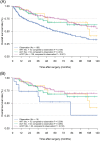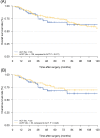Decision-making of adjuvant therapy in pT1N1M0 gastric cancer: Should radiotherapy be added to chemotherapy? A propensity score-matched analysis
- PMID: 33442416
- PMCID: PMC7797651
- DOI: 10.7150/jca.52123
Decision-making of adjuvant therapy in pT1N1M0 gastric cancer: Should radiotherapy be added to chemotherapy? A propensity score-matched analysis
Abstract
Background: Early gastric cancer (EGC) with metastatic lymph nodes (mLNs) has a relatively higher recurrence rate and poorer prognosis than EGC without mLNs. However, the postoperative treatment directions of pT1N1M0 vary from different guidelines. This study attempted to confirm the value of postoperative treatments in pT1N1M0 GC patients. Methods: Overall, 379 patients with pT1N1M0 GC following gastrectomy from 2000 to 2016 were selected from the Surveillance, Epidemiology, and End Results (SEER) database. Propensity score-matched (PSM) analysis was used to reduce bias. Overall survival was analyzed by Kaplan-Meier method and the log-rank test. Cox proportional hazards regression analyses were used to confirm the independent prognostic factors. Results: Before matching, the results of survival analyses indicated that adjuvant chemotherapy (ACT) and chemoradiotherapy (ACRT) could significantly prolong the survival time of the cohort (P < 0.05). After PSM analysis, 136 patients remained and ACRT maintained significance in the survival analysis (P = 0.018). Furthermore, patients with well or moderately differentiated GC (HR = 0.226, P =0.018) or intestinal type GC (HR = 0.380, P = 0.040) achieved a significantly superior prognosis with ACRT, compared to patients receiving ACT. Conclusion: The survival benefit of ACRT and ACT for pT1N1M0 GC patients following gastrectomy was confirmed in the SEER cohort. RT added to ACT might be recommended according to Lauren's classification and tumor grade in clinical decision making.
Keywords: adjuvant therapy; early gastric cancer; lymph node metastasis; propensity score-matched analysis; radiotherapy.
© The author(s).
Conflict of interest statement
Competing Interests: The authors have declared that no competing interest exists.
Figures






References
-
- Lai JF, Kim S, Kim K. et al. Prediction of recurrence of early gastric cancer after curative resection. Annals of surgical oncology. 2009;16(7):1896–1902. - PubMed
-
- HG Y, JY A, MG C. et al. Recurrence after curative resection of early gastric cancer. Annals of surgical oncology. 2010;17(2):448–454. - PubMed
-
- Lo SS, Wu CW, Chen JH. et al. Surgical results of early gastric cancer and proposing a treatment strategy. Annals of surgical oncology. 2007;14(2):340–347. - PubMed
LinkOut - more resources
Full Text Sources
Other Literature Sources
Miscellaneous

